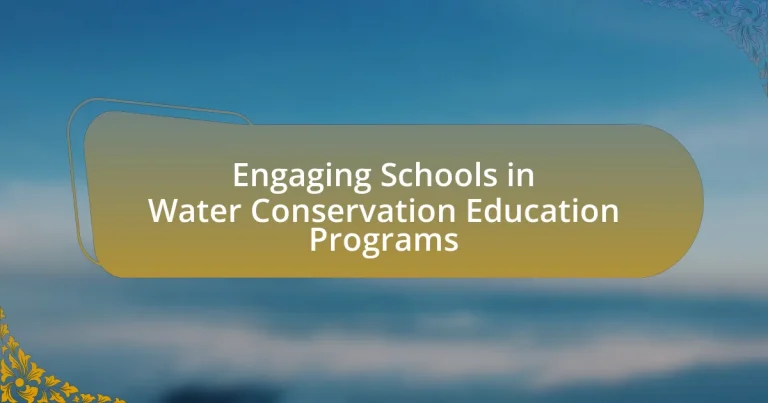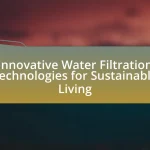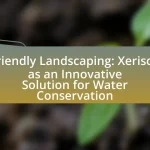Water Conservation Education Programs in schools are structured initiatives aimed at teaching students the significance of water conservation and sustainable management practices. These programs utilize interactive lessons, hands-on activities, and community projects to enhance student awareness and promote responsible water usage, with research indicating reductions in water consumption by up to 20% in participating schools. Effective engagement strategies include experiential learning methods, collaboration with local organizations, and the integration of technology, all of which contribute to improved student knowledge retention and community involvement. The article explores the importance of these educational programs, the challenges schools face, and best practices for implementation, highlighting the measurable outcomes of successful water conservation initiatives.
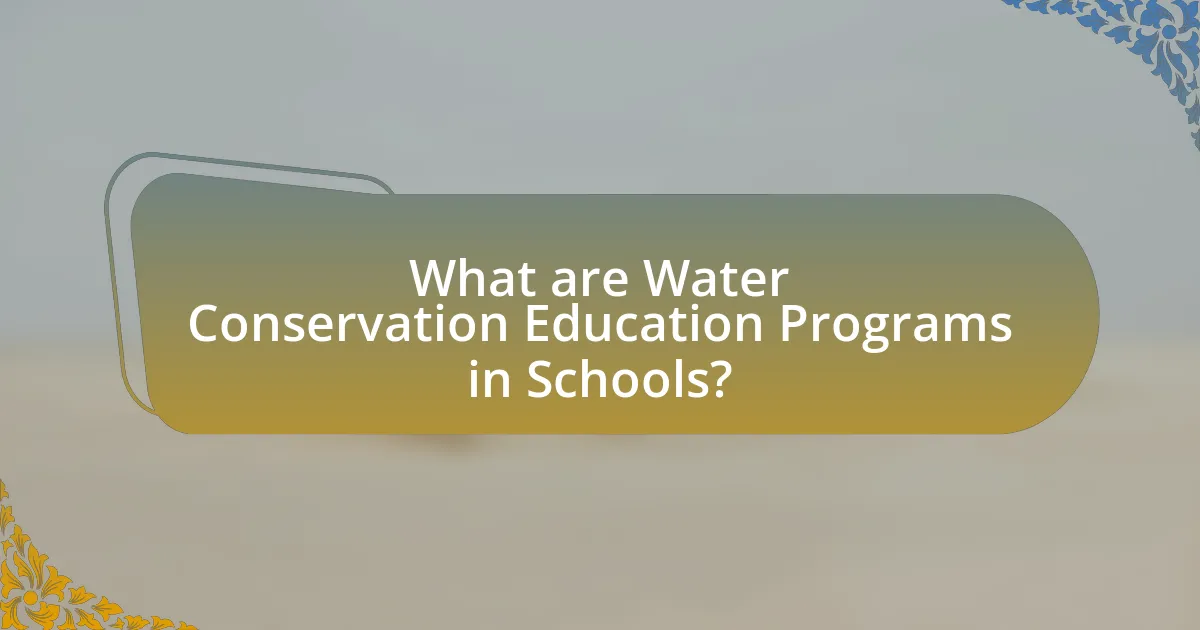
What are Water Conservation Education Programs in Schools?
Water Conservation Education Programs in schools are structured initiatives designed to teach students about the importance of water conservation and sustainable water management practices. These programs often include interactive lessons, hands-on activities, and community projects that engage students in understanding water scarcity issues and the impact of their water usage. Research indicates that such educational efforts can significantly increase students’ awareness and promote responsible water use behaviors, as evidenced by studies showing that schools implementing these programs report a reduction in water consumption by up to 20%.
How do these programs engage students and educators?
These programs engage students and educators by incorporating interactive learning experiences that promote active participation in water conservation. For instance, hands-on activities such as water audits and conservation projects allow students to apply their knowledge in real-world contexts, fostering a deeper understanding of water issues. Additionally, educators receive training and resources that equip them to effectively teach water conservation concepts, enhancing their instructional methods. Research indicates that programs utilizing experiential learning techniques significantly increase student engagement and retention of information, demonstrating the effectiveness of these approaches in educational settings.
What teaching methods are most effective in water conservation education?
Interactive and experiential learning methods are most effective in water conservation education. These approaches engage students actively, allowing them to participate in hands-on activities such as water audits, experiments, and community projects. Research indicates that experiential learning increases retention rates and fosters a deeper understanding of water conservation principles. For example, a study by the National Oceanic and Atmospheric Administration found that students who participated in hands-on water conservation projects demonstrated a 30% increase in knowledge retention compared to traditional lecture-based methods. This evidence supports the effectiveness of interactive teaching methods in promoting water conservation education.
How can schools incorporate hands-on activities in these programs?
Schools can incorporate hands-on activities in water conservation education programs by implementing practical projects such as rainwater harvesting systems, water audits, and community clean-up events. These activities allow students to actively engage with water conservation concepts, fostering a deeper understanding of their importance. For instance, a study by the Water Education Foundation found that students participating in hands-on projects showed a 30% increase in knowledge retention compared to traditional learning methods. Additionally, schools can collaborate with local environmental organizations to facilitate workshops that provide students with real-world applications of water conservation techniques.
Why is water conservation education important for schools?
Water conservation education is important for schools because it fosters awareness and responsibility among students regarding water usage and sustainability. By integrating water conservation into the curriculum, schools can equip students with the knowledge and skills necessary to make informed decisions about water resources. Research indicates that educational programs focused on water conservation can lead to a significant reduction in water consumption; for instance, a study by the American Water Works Association found that schools implementing such programs reduced water usage by up to 20%. This education not only promotes environmental stewardship but also prepares students to address future water scarcity challenges effectively.
What impact does water conservation education have on student awareness?
Water conservation education significantly enhances student awareness about the importance of sustainable water use. Research indicates that students exposed to water conservation programs demonstrate increased knowledge regarding water scarcity, conservation techniques, and the environmental impact of water misuse. For instance, a study published in the Journal of Environmental Education found that students participating in water conservation initiatives showed a 40% increase in their understanding of water-related issues compared to those who did not participate. This heightened awareness often translates into behavioral changes, such as reduced water consumption and increased advocacy for water-saving practices within their communities.
How does it contribute to the overall sustainability goals of schools?
Engaging schools in water conservation education programs significantly contributes to the overall sustainability goals of schools by promoting responsible water usage and environmental stewardship among students. These programs educate students about the importance of water conservation, leading to reduced water waste and fostering a culture of sustainability within the school community. For instance, schools that implement water-saving practices, such as rainwater harvesting and efficient irrigation systems, can decrease their water consumption by up to 30%, directly supporting sustainability targets. Additionally, by integrating water conservation into the curriculum, schools empower students to become advocates for sustainable practices, thereby extending the impact beyond the classroom and into their homes and communities.
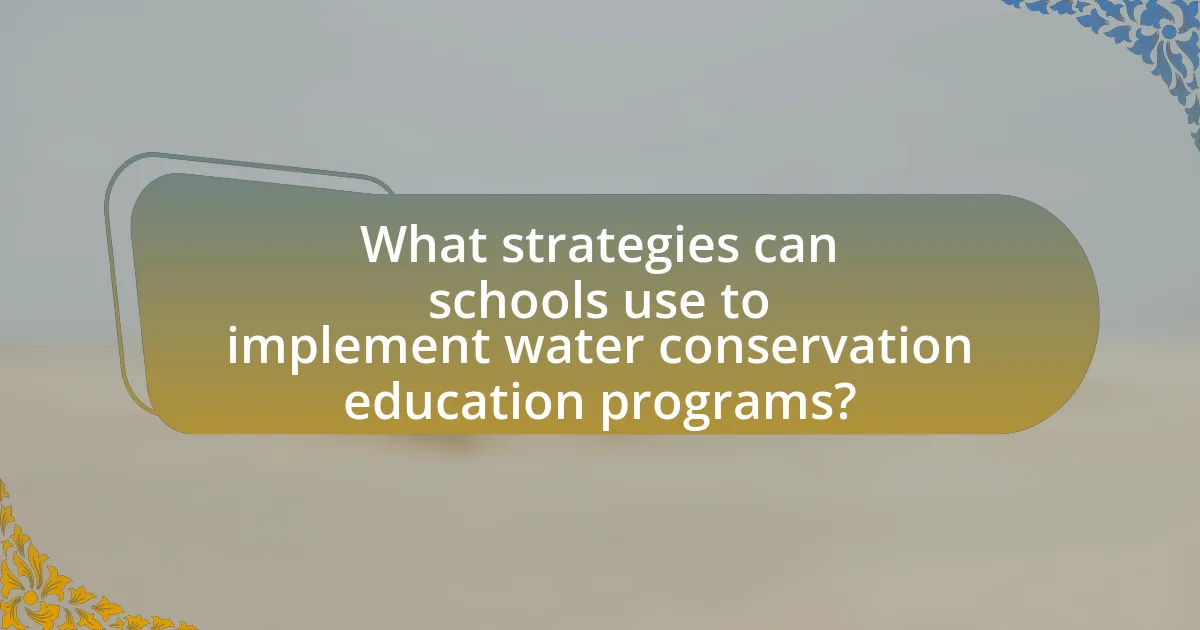
What strategies can schools use to implement water conservation education programs?
Schools can implement water conservation education programs by integrating hands-on activities, curriculum development, and community partnerships. Hands-on activities, such as school-wide water audits and rainwater harvesting projects, engage students directly in conservation efforts, fostering a practical understanding of water usage. Curriculum development can include lessons on the water cycle, the importance of water conservation, and the impact of water scarcity, aligning with science and environmental education standards. Additionally, forming partnerships with local water authorities and environmental organizations can provide resources, expertise, and support for educational initiatives, enhancing the program’s effectiveness. These strategies have been shown to increase student awareness and promote sustainable practices within the school community.
How can schools collaborate with local organizations for better outreach?
Schools can collaborate with local organizations for better outreach by establishing partnerships that leverage resources and expertise. For instance, schools can work with environmental organizations to develop water conservation education programs that include workshops, field trips, and community events. These partnerships can enhance the curriculum by providing real-world applications of water conservation principles, thereby increasing student engagement and community awareness. Research shows that schools involved in community partnerships report higher student participation and improved educational outcomes, as evidenced by a study published in the Journal of Environmental Education, which highlights the effectiveness of collaborative programs in fostering environmental stewardship among students.
What role do community partnerships play in enhancing these programs?
Community partnerships significantly enhance water conservation education programs by providing resources, expertise, and local engagement. These collaborations enable schools to access funding, educational materials, and volunteer support, which are crucial for implementing effective programs. For instance, partnerships with local water agencies can offer specialized knowledge on water conservation techniques, while collaboration with community organizations can facilitate outreach efforts, ensuring broader participation. Research indicates that programs involving community partnerships have higher success rates in achieving educational goals and fostering sustainable practices among students, as evidenced by case studies showing increased student engagement and improved water-saving behaviors in schools that actively collaborate with local stakeholders.
How can schools leverage technology to promote water conservation education?
Schools can leverage technology to promote water conservation education by integrating digital tools such as interactive apps, online platforms, and virtual simulations into their curricula. These technologies can facilitate engaging learning experiences, allowing students to visualize water usage, track consumption, and understand the impact of conservation efforts. For instance, studies have shown that using gamified applications can increase student engagement and knowledge retention, leading to a 20% improvement in water conservation awareness among participants. Additionally, online resources and webinars can connect students with experts in the field, providing real-time insights and fostering a deeper understanding of water conservation practices.
What resources are available for schools to support water conservation education?
Schools can access a variety of resources to support water conservation education, including curriculum guides, interactive lesson plans, and online platforms. Organizations such as the Environmental Protection Agency (EPA) provide educational materials specifically designed for K-12 students, which include activities and resources that promote understanding of water conservation principles. Additionally, the WaterSense program offers a range of tools and resources, including lesson plans and promotional materials, to help educators teach students about water efficiency. Research indicates that engaging students through hands-on activities and real-world applications significantly enhances their understanding of water conservation, making these resources effective in fostering awareness and responsible water use.
Which organizations provide educational materials and training for teachers?
Organizations that provide educational materials and training for teachers include the National Education Association (NEA), the American Federation of Teachers (AFT), and the National Science Teachers Association (NSTA). The NEA offers resources and professional development opportunities aimed at enhancing teaching practices, while the AFT provides various training programs and materials to support educators. The NSTA focuses specifically on science education, offering a wealth of resources for teachers to improve their science instruction. These organizations are recognized for their contributions to teacher education and professional development, ensuring educators have access to high-quality materials and training.
How can schools access funding for water conservation initiatives?
Schools can access funding for water conservation initiatives through various sources, including government grants, nonprofit organizations, and local community programs. For example, the U.S. Environmental Protection Agency offers grants specifically aimed at water conservation projects in schools, which can be applied for through their website. Additionally, organizations like the National Wildlife Federation provide funding opportunities for educational programs focused on water conservation. Local water districts often have programs that support schools in implementing water-saving technologies, such as rainwater harvesting systems. These funding sources are designed to promote sustainable practices and enhance educational experiences related to water conservation.
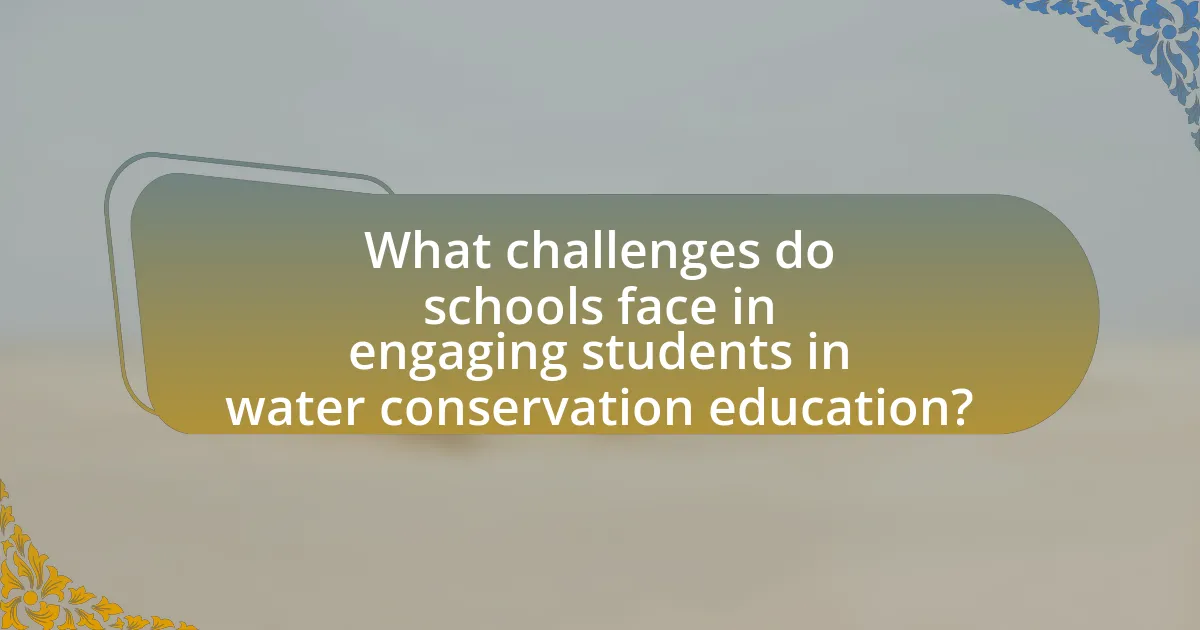
What challenges do schools face in engaging students in water conservation education?
Schools face several challenges in engaging students in water conservation education, primarily due to limited resources, lack of curriculum integration, and insufficient teacher training. Limited resources hinder the development and implementation of effective programs, as schools may lack funding for materials and activities. Additionally, water conservation education is often not integrated into existing curricula, making it difficult for educators to prioritize it amidst other subjects. Furthermore, many teachers may not have received adequate training on water conservation topics, which can lead to a lack of confidence in delivering the content effectively. These factors collectively impede the ability of schools to engage students meaningfully in water conservation education.
How can schools overcome barriers to student participation?
Schools can overcome barriers to student participation by implementing inclusive teaching strategies and fostering a supportive environment. Research indicates that when schools adopt differentiated instruction, they cater to diverse learning styles, which enhances engagement. For instance, a study by Tomlinson (2001) highlights that tailoring lessons to meet individual needs can significantly increase student involvement. Additionally, creating a culture of belonging through peer support programs and mentorship can further encourage participation, as evidenced by findings from the National Center for School Engagement, which show that students are more likely to participate when they feel connected to their school community.
What strategies can be employed to maintain student interest over time?
To maintain student interest over time in water conservation education programs, interactive and hands-on learning experiences should be employed. Research indicates that students are more engaged when they participate in activities such as experiments, field trips, and community projects related to water conservation. For instance, a study by the National Oceanic and Atmospheric Administration found that students who participated in hands-on environmental projects showed a 30% increase in interest and retention of information compared to traditional lecture-based learning. Additionally, incorporating technology, such as gamified learning platforms and virtual simulations, can further enhance engagement by making learning more dynamic and relatable.
How can schools address misconceptions about water conservation?
Schools can address misconceptions about water conservation by implementing comprehensive educational programs that focus on accurate information and practical applications. These programs should include interactive lessons, workshops, and hands-on activities that demonstrate the importance of water conservation and the impact of individual actions. Research indicates that experiential learning significantly enhances understanding; for example, a study by the Water Education Foundation found that students who participated in water conservation projects showed a 30% increase in knowledge retention compared to traditional teaching methods. By utilizing data-driven approaches and engaging students in real-world scenarios, schools can effectively dispel myths and foster a culture of responsible water use.
What are the measurable outcomes of successful water conservation education programs?
Successful water conservation education programs lead to measurable outcomes such as reduced water consumption, increased awareness of water issues, and enhanced community engagement. For instance, studies have shown that schools implementing these programs can achieve a 20-30% reduction in water usage within a year, as evidenced by data from the California Department of Water Resources. Additionally, participants often demonstrate a 50% increase in knowledge about water conservation practices, which is measured through pre- and post-program surveys. Furthermore, community involvement typically rises, with programs reporting a 40% increase in local participation in water-saving initiatives, highlighting the broader impact of education on community behavior.
How can schools assess the effectiveness of their programs?
Schools can assess the effectiveness of their programs by implementing a combination of quantitative and qualitative evaluation methods. Quantitative assessments can include pre- and post-program surveys measuring students’ knowledge and attitudes towards water conservation, while qualitative assessments can involve focus groups or interviews with students and teachers to gather insights on program engagement and impact. Research indicates that programs with structured evaluation frameworks, such as those outlined by the American Evaluation Association, demonstrate improved outcomes, as they allow for data-driven adjustments and enhancements to educational strategies.
What indicators show improved student engagement and knowledge retention?
Improved student engagement and knowledge retention can be indicated by increased participation in class discussions and activities. Research shows that when students actively participate, they are more likely to retain information, as evidenced by a study conducted by the National Training Laboratories, which found that learners retain approximately 70% of what they actively engage with compared to only 10% from lectures. Additionally, higher scores on assessments and improved attendance rates also serve as indicators of enhanced engagement and retention, as students who are more involved tend to perform better academically.
What best practices can schools adopt for effective water conservation education?
Schools can adopt hands-on learning experiences as a best practice for effective water conservation education. Engaging students in practical activities, such as water audits or creating rain gardens, allows them to directly observe the impact of water conservation efforts. Research indicates that experiential learning significantly enhances retention of information, with studies showing that students who participate in hands-on activities are more likely to apply what they learn in real-life situations. Additionally, integrating water conservation topics into the curriculum across subjects, such as science, math, and social studies, reinforces the importance of water conservation and its relevance to various fields. This multidisciplinary approach has been supported by educational frameworks that emphasize the interconnectedness of environmental issues.
